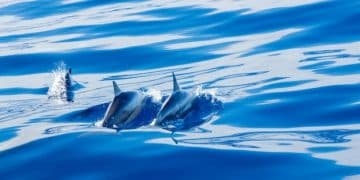US Marine Mammal Protection Act 2025: Coastal Impact

The updated US Marine Mammal Protection Act in 2025 reshapes environmental regulations, significantly influencing fishing practices, tourism, and infrastructure development across coastal communities by balancing conservation with economic realities and fostering new avenues for sustainable coexistence.
Coastal communities across the United States are on the cusp of significant changes as the updated US Marine Mammal Protection Act (MMPA) is set to take effect in 2025. This legislative revision promises to redefine the delicate balance between vital marine conservation efforts and the economic and social fabric of maritime regions, prompting both anticipation and strategic recalibration from stakeholders.
Understanding the Updated Marine Mammal Protection Act
The Marine Mammal Protection Act, originally enacted in 1972, stands as a cornerstone of US marine conservation law. Its primary goal has always been to protect and conserve marine mammal populations from human activities, reflecting a growing awareness of ecological interconnectedness. This foundational legislation prohibits the “take” of marine mammals, which includes hunting, harassing, capturing, or killing them, without proper authorization.
Over the decades, the MMPA has undergone various amendments to adapt to evolving scientific understanding, changing conservation needs, and new forms of human interaction with marine environments. These adjustments have often involved refining definitions, strengthening enforcement mechanisms, and integrating provisions for habitat protection and international cooperation. The upcoming 2025 updates represent another critical juncture in this ongoing evolution, aiming to address contemporary challenges and enhance the Act’s effectiveness in safeguarding these vulnerable species.
Key Drivers Behind the 2025 Amendments
Several factors have converged to necessitate the latest round of MMPA updates. Scientific research continually provides new insights into marine mammal behavior, population dynamics, and the impacts of human activities. For instance, the increasing understanding of acoustic pollution’s effects on cetaceans or the cumulative stress on pinnipeds from habitat degradation has underscored the need for more nuanced regulations. Additionally, technological advancements, such as improved tracking systems or offshore energy development, present both new opportunities for impact mitigation and new challenges for wildlife management.
Another significant driver is the increasing pressure from climate change. Rising ocean temperatures, ocean acidification, and altered prey distributions are profoundly affecting marine mammal habitats and migratory patterns. The updated MMPA seeks to incorporate provisions that allow for greater adaptive management in the face of these rapid environmental shifts. Furthermore, international conventions and agreements often influence domestic policy, compelling the US to align its conservation efforts with global best practices and shared environmental goals.
- Scientific Advancements: New data on marine mammal health, populations, and anthropogenic impacts.
- Technological Developments: Emergence of new industries and methods affecting marine environments.
- Climate Change Impacts: Addressing the profound effects of warming oceans and habitat alteration.
- International Alignment: Harmonizing US laws with global conservation standards and treaties.
The updates are not simply a reactive measure; they also reflect a proactive attempt to build more resilient ecosystems and more sustainable human practices. By integrating the latest scientific data and anticipating future challenges, the 2025 MMPA aims to establish a framework that protects marine mammals while also considering the complex interplay with human socio-economic systems. This forward-looking approach is crucial for long-term conservation success.
At its core, the updated MMPA embodies a commitment to adaptive management, allowing for flexibility and responsiveness. This means establishing clearer guidelines for permitting activities, enhancing monitoring and enforcement capabilities, and fostering collaborative efforts between government agencies, industries, and conservation organizations. The legislation also emphasizes the importance of public engagement and awareness, recognizing that effective conservation relies on a shared understanding and commitment from all stakeholders.
Impact on Commercial Fishing and Aquaculture
The commercial fishing and aquaculture industries are intrinsically linked to the health of marine ecosystems, and as such, they often experience direct and significant impacts from marine conservation legislation. The updated MMPA in 2025 is set to introduce several changes that will necessitate adjustments in operational practices for these sectors. These changes are primarily aimed at reducing accidental entanglement and bycatch, which remain major threats to marine mammal populations globally. New requirements may include modifications to fishing gear, such as the adoption of ropeless technologies or specific acoustic deterrents designed to guide marine mammals away from fishing areas without harming them.
Furthermore, there could be tighter regulations on fishing seasons or designated areas where marine mammals are known to congregate, especially during critical breeding or feeding times. This could lead to temporary or permanent closures of certain fishing grounds, which would naturally impact vessel operations and yield. The aquaculture sector might face increased scrutiny regarding the siting of farms to avoid marine mammal migration routes and habitat ares, as well as new standards for net enclosure designs to prevent entanglements. Compliance with these new regulations often entails significant financial investment for equipment upgrades, retraining of personnel, and obtaining new certifications.
Adjustments and Adaptations Required
For many fishing operations, particularly smaller-scale and artisanal fisheries, the cost of implementing new gear or altering established practices can be substantial. This raises concerns about economic viability and the potential for displacement of traditional fishing communities. However, the legislation also aims to incentivize the adoption of sustainable practices through potential grants or assistance programs designed to ease the transition. Workshops and training sessions will likely be crucial in disseminating information about new technologies and compliance procedures, ensuring that fishers have the knowledge and resources to adapt effectively.
- Gear Modifications: Transition to ropeless systems, acoustic deterrents, and modified net designs.
- Seasonal/Area Restrictions: Potential closures or limitations in sensitive marine mammal habitats.
- Increased Monitoring: Greater onboard observer coverage or electronic monitoring requirements.
- Financial Implications: Costs for upgrades, training, and potential loss of revenue from closures.
The updated MMPA also emphasizes the need for comprehensive data collection regarding interactions between fishing gear and marine mammals. This could involve more rigorous reporting requirements for accidental catches or observations, providing valuable data for adaptive management strategies. While this might add to the administrative burden for fishers, it is essential for the long-term effectiveness of conservation efforts. Collaboration between industry stakeholders, conservation groups, and government agencies will be key to developing practical and effective solutions that balance economic needs with ecological protection.
In the long run, these adjustments are expected to lead to more sustainable fishing practices, potentially improving the health of marine ecosystems and ultimately benefiting the fishing industry itself by ensuring the longevity of fish stocks and biodiversity. The transition, however, will require careful planning, clear communication, and ongoing support for the affected communities to navigate the challenges successfully. The focus will be on finding solutions that reduce conflicts and promote coexistence, ensuring the vitality of both marine life and coastal livelihoods.

Tourism and Recreation Sector Implications
The tourism and recreation sectors in coastal communities, particularly those centered around marine wildlife viewing, are heavily reliant on the health and accessibility of marine mammal populations. The updated U.S. Marine Mammal Protection Act (MMPA) in 2025 is poised to introduce new guidelines and restrictions that will directly affect operations ranging from whale watching tours to recreational boating and diving. The primary objective of these changes is to minimize disturbance and ensure the long-term well-being of marine mammals, which can be unintentionally stressed or harmed by close human interactions.
New regulations might include stricter minimum approach distances for vessels, limitations on the number of boats in a viewing area, or specific time-of-day restrictions for certain activities, especially during sensitive breeding or calving seasons. For whale watching operators, this could mean adjusting tour routes, durations, or the size of their fleets. Recreational boaters might face enhanced educational requirements or new permitting processes to operate in designated marine mammal habitats. Kayaking, paddleboarding, and even drone usage near marine animals could also come under review, with an emphasis on preventing undue disturbance.
Navigating New Operational Guidelines
Compliance with these updated guidelines will demand a proactive approach from tourism businesses. Investing in new training for guides and operators to ensure they understand and adhere to the revised regulations will be crucial. This might involve specialized courses on marine mammal behavior, responsible viewing practices, and emergency response protocols. For many businesses, the change emphasizes sustainability as a core component of their brand, potentially attracting eco-conscious tourists who value responsible wildlife encounters.
- Stricter Proximity Rules: New minimum approach distances for all types of vessels.
- Activity Limitations: Possible restrictions on vessel numbers, duration, or timing of tours.
- Enhanced Education: Mandatory training for marine tour operators and public outreach campaigns.
- Technological Solutions: Adoption of quiet propulsion systems or advanced monitoring tools.
While some immediate operational adjustments and potential financial outlays for training or equipment might occur, the long-term benefits for the tourism sector are significant. Healthy and thriving marine mammal populations are a major draw for tourists, and ensuring their protection helps sustain the very resource that drives these businesses. By aligning with robust conservation standards, coastal tourism can enhance its reputation, contributing to a more sustainable and resilient local economy. The emphasis on responsible tourism also provides an opportunity for operators to differentiate themselves in a competitive market.
Furthermore, these regulations aren’t just about restrictions; they also open doors for collaboration. Tourism operators can partner with conservation organizations and government agencies to contribute to monitoring efforts, educate their clients, and even participate in citizen science initiatives. This collaborative model transforms operators from merely obeying rules into active stewards of the marine environment. Ultimately, the updated MMPA aims to foster a more harmonious relationship between human recreational activities and the natural world, safeguarding these iconic species for future generations of both wildlife and enthusiasts.
Infrastructure and Development Challenges
Coastal communities are dynamic environments, constantly balancing the need for economic development and infrastructure improvements with the imperative of environmental protection. The updated US Marine Mammal Protection Act (MMPA) in 2025 will introduce new considerations for infrastructure projects and coastal development, particularly those involving construction, dredging, and energy initiatives in marine or coastal zones. These changes are primarily aimed at mitigating the direct and indirect impacts of human development on marine mammal habitats, migration routes, and acoustic environments.
Projects such as port expansions, offshore wind farms, bridge construction, or coastal erosion control measures could face more stringent environmental impact assessments. This might involve more detailed studies on the potential effects of underwater noise from pile driving, vibratory hammer operations, or increased vessel traffic. Developers may be required to implement advanced mitigation strategies, such as soft-start piling, acoustic monitoring systems, or seasonal restrictions on construction activities to avoid critical periods for marine mammals like breeding or migration seasons. The potential for delays or increased costs due to these new regulatory hurdles is a significant concern for developers and local governments alike.
Mitigation Strategies and Innovation
To navigate these new challenges, coastal developers and planning agencies will need to adopt innovative approaches and enhance their collaborative efforts. Early engagement with environmental consultants, marine biologists, and regulatory bodies will be crucial to identify potential conflicts and design projects that minimize impact from the outset. This could involve exploring alternative construction methods that produce less underwater noise or designing infrastructure that incorporates marine mammal friendly elements, such as reduced light pollution from coastal facilities.
- Enhanced Environmental Assessments: More rigorous studies on noise, habitat disruption, and vessel traffic impacts.
- Advanced Mitigation Technologies: Use of bubble curtains, low-frequency sound dampeners, or quieter construction methods.
- Seasonal Restrictions: Limiting construction activities during sensitive marine mammal periods.
- Siting and Planning Adjustments: Re-evaluating project locations to avoid critical habitats or migration corridors.
The updated MMPA also emphasizes the importance of cumulative impact assessments, meaning that individual projects will be evaluated not just on their own merits but in the context of other existing or planned developments in a region. This holistic approach aims to prevent a series of seemingly minor impacts from collectively causing significant harm to marine mammal populations. For local authorities, this necessitates a more integrated approach to coastal zone management, coordinating across various departments and jurisdictions to ensure consistent compliance and long-term sustainability.

While these regulations present undeniable challenges, they also drive innovation in sustainable development practices. Companies that invest in quieter construction technologies or develop expertise in marine mammal-friendly design could gain a competitive advantage. Furthermore, successful navigation of these regulations can lead to more resilient coastal infrastructure that is harmonious with its natural surroundings, ultimately enhancing the long-term environmental and economic health of coastal communities. The goal is to ensure that essential development can proceed in a manner that is both economically viable and ecologically responsible.
Economic Repercussions and Opportunities
The updated US Marine Mammal Protection Act (MMPA) in 2025, while primarily a conservation measure, will inevitably cast a long shadow over the economic landscape of coastal communities. Businesses directly involved in maritime industries—fishing, tourism, shipping, and offshore energy—will face new costs associated with compliance, such as investing in new technologies, modifying operational procedures, or adapting to restricted access to certain areas or resources. These expenditures, particularly for smaller enterprises, could pose significant financial strains, potentially leading to reduced profits or, in some cases, business closures.
The shift to more environmentally sensitive practices may also result in temporary or localized job losses in heavily impacted sectors as companies retool or downsize. For instance, a fishing fleet unable to afford new ropeless gear might reduce its operational capacity. Similarly, construction projects might experience delays and increased budgets due to stricter environmental assessments and mitigation requirements. These direct economic impacts can ripple through local economies, affecting ancillary services, supply chains, and overall community prosperity if not managed proactively.
Unlocking New Economic Avenues
Despite these challenges, the updated MMPA also presents significant opportunities for economic innovation and growth in coastal communities. The demand for new, marine mammal-friendly technologies will spur innovation in manufacturing and engineering. This could lead to the development of specialized “green” maritime equipment, creating new jobs in research, development, and production. Companies specializing in environmental consulting, marine surveying, and impact mitigation services will likely see increased demand for their expertise.
- New Green Industries: Growth in eco-friendly maritime technology and environmental services.
- Ecotourism Expansion: Increased demand for responsible, conservation-focused marine experiences.
- Research & Development: Investments in scientific studies and innovative conservation solutions.
- Sustainable Branding: Enhanced marketability for businesses adhering to high environmental standards.
Moreover, the strengthening of marine mammal populations and their habitats can boost ecotourism. A healthy marine environment, rich with diverse wildlife, attracts more visitors interested in responsible viewing, diving, and nature photography. This, in turn, can stimulate growth in hospitality, local retail, and outdoor recreation sectors. Communities that embrace and promote their commitment to conservation could establish themselves as premier destinations for sustainable tourism, generating long-term revenue and enhancing their global reputation.
The transition may also facilitate the adoption of more sustainable resource management practices, leading to healthier fish stocks and more resilient coastal ecosystems in the long run. Over time, this could stabilize or even increase yields for the fishing industry by ensuring the viability of marine resources. Government agencies and non-profit organizations are likely to offer grants, subsidies, and technical assistance programs to help businesses and communities adapt, cushioning the immediate economic impacts and fostering new growth. Proactive community planning and diverse stakeholder engagement will be crucial to maximize the opportunities presented by the updated MMPA and mitigate potential economic downsides, steering coastal economies towards a more sustainable and prosperous future.
Community Adaptation and Engagement
The success of the updated Marine Mammal Protection Act (MMPA) in 2025 hinges significantly on the ability of coastal communities to adapt and engage with the new regulations. These communities are on the front lines of both economic activity and environmental stewardship, making their understanding and participation critical. Adaptation will require clear and consistent communication from regulatory bodies, ensuring that affected businesses and residents are fully informed about the changes, their implications, and the resources available to assist with compliance. This includes workshops, informational campaigns, and accessible guides to the new rules.
Engagement involves not just compliance but active participation in the conservation process. This could manifest through community-led monitoring programs where local citizens contribute valuable data on marine mammal sightings or disturbances. Fishermen, for example, often possess deep traditional knowledge of local marine environments and can offer unique insights into patterns of marine mammal movement or effective fishing gear modifications. Their engagement in adaptive management strategies can lead to more practical and effective solutions than those designed solely by regulators.
Fostering Collaborative Solutions
Building strong collaborative frameworks between government agencies, local industries, scientific institutions, and conservation groups will be essential. These partnerships can facilitate the exchange of information, identify shared challenges, and co-create innovative solutions. For instance, joint research initiatives could explore new technologies to reduce marine mammal interactions without unduly burdening specific industries. Community-based stakeholder groups can serve as vital conduits for feedback, ensuring that the implementation of the MMPA remains flexible and responsive to local conditions.
- Information Dissemination: Workshops, public forums, and accessible online resources for stakeholders.
- Citizen Science Programs: Empowering locals to contribute to marine mammal monitoring and data collection.
- Industry Consultations: Direct engagement with fishing, tourism, and development sectors to gather feedback.
- Collaborative Research: Partnerships between communities, scientists, and industry on mitigation technologies.
Another aspect of community adaptation involves fostering a culture of ecological literacy. Educational programs in schools and public outreach initiatives can raise awareness about marine mammal conservation and the importance of the MMPA among younger generations and the broader public. This helps build a supportive community ethos that values and actively participates in protecting marine life, laying the groundwork for long-term conservation success. By fostering a collective sense of responsibility, communities can become powerful advocates for their marine environments.
Ultimately, the challenges presented by the updated MMPA also offer an opportunity for coastal communities to emerge stronger and more resilient. By embracing adaptive strategies, leveraging local knowledge, and fostering robust partnerships, these communities can not only meet the requirements of the new legislation but also demonstrate leadership in sustainable coexistence. This proactive approach ensures that coastal economies thrive in harmony with a flourishing marine ecosystem, reinforcing the idea that conservation and prosperity are not mutually exclusive but deeply interconnected.
Future Outlook and Long-Term Sustainability
The implementation of the updated US Marine Mammal Protection Act (MMPA) in 2025 is not merely a regulatory adjustment; it represents a pivotal step towards a more sustainable future for marine ecosystems and the coastal communities that depend on them. The long-term outlook under the new framework is one of enhanced ecological resilience and potentially more stable economic opportunities, though the transition period will undoubtedly require careful navigation and concerted effort from all stakeholders. The act’s emphasis on adaptive management suggests a dynamic approach to conservation, allowing for continuous refinement based on new scientific data and practical experiences.
In the long run, healthier marine mammal populations contribute significantly to the overall vitality of marine ecosystems. As apex predators and integral components of food webs, marine mammals play a critical role in maintaining ecological balance. Their well-being can be an indicator of broader ocean health, which directly benefits fishing stocks, biodiversity, and ecosystem services that support human life. This improved environmental health, in turn, underpins more robust and sustainable tourism, recreational activities, and even commercial fisheries, creating a positive feedback loop for coastal economies.
Pathways to Resilient Coastal Futures
Achieving long-term sustainability will require ongoing investment in scientific research and monitoring to assess the effectiveness of new regulations and identify emerging threats. Funding for innovative conservation technologies, such as advanced acoustic monitoring or non-lethal deterrents, will also be crucial. Furthermore, consistent enforcement of the MMPA provisions, coupled with educational initiatives, will be necessary to ensure widespread compliance and foster a shared commitment to marine protection across all sectors.
- Enhanced Ecosystem Health: Robust marine mammal populations indicating overall ocean vitality.
- Sustainable Economic Growth: Long-term benefits for ecotourism, fishing, and related industries.
- Continued Research: Ongoing scientific studies to inform adaptive management and policy.
- Innovation & Technology: Development and adoption of new tools for conservation and impact mitigation.
For coastal communities, the journey towards sustainability under the updated MMPA is an opportunity to diversify their economies and build resilience against future environmental and economic shocks. By embracing eco-friendly practices, promoting responsible resource use, and fostering strong collaborations between local government, industries, and environmental groups, communities can position themselves as leaders in sustainable development. This collaborative model ensures that economic progress occurs in harmony with ecological preservation.
The success of the updated MMPA will ultimately be measured not just by the health of marine mammal populations but also by the prosperity and adaptability of the human communities alongside them. It is a testament to the belief that conservation is not an impediment to progress but a prerequisite for lasting prosperity. As 2025 approaches and the new provisions take effect, the enduring commitment to protecting marine mammals will lay the groundwork for a more balanced and sustainable relationship between humanity and the invaluable marine environment.
| Key Area | Brief Description of Impact |
|---|---|
| 🐠 Commercial Fishing | Requires gear modifications & potential area/time restrictions for marine mammal protection. |
| 🛥️ Tourism & Recreation | Stricter approach distances and viewing guidelines for responsible marine wildlife interaction. |
| 🏗️ Infrastructure & Dev. | More stringent environmental assessments & noise mitigation for coastal projects. |
| 💰 Economic Outlook | Challenges due to compliance costs, but new opportunities in green technologies & ecotourism. |
Frequently Asked Questions
▼
The primary goal is to enhance the protection of marine mammal populations from human activities, incorporating new scientific understandings and addressing emerging threats like climate change and increased ocean noise. It seeks to balance conservation needs with the economic realities of coastal communities by establishing clearer guidelines and fostering sustainable practices.
▼
Commercial fishing will likely see new requirements for gear modification, such as the adoption of ropeless systems or acoustic deterrents to reduce bycatch and entanglement. There may also be tighter regulations on fishing seasons or specific areas to protect marine mammals during critical life stages, requiring operational adjustments and potential financial investments.
▼
Coastal tourism, especially marine wildlife viewing, will face stricter minimum approach distances for vessels and potential limitations on the number of boats in sensitive viewing areas. These measures aim to minimize disturbance to marine mammals. Operators may need to invest in new training and sustainable practices, which can also enhance their appeal to eco-conscious tourists.
▼
Yes, coastal development, including port expansions and offshore energy projects, may face more stringent environmental impact assessments. This could require developers to implement advanced mitigation strategies for underwater noise and consider seasonal construction restrictions to avoid critical marine mammal periods, potentially leading to increased costs or project delays.
▼
Absolutely. The updated MMPA can foster new economic opportunities in green technologies, such as manufacturing eco-friendly fishing gear or acoustic mitigation devices. It can also boost ecotourism by ensuring healthier marine environments, and increase demand for environmental consulting services, creating new jobs and promoting sustainable economic diversification in coastal areas.
Conclusion
The updated US Marine Mammal Protection Act in 2025 marks a pivotal moment for coastal communities, introducing a new era of conservation that will reshape economic activities, development practices, and our collective relationship with the marine environment. While the transition presents challenges in terms of compliance and adaptation for industries like fishing, tourism, and infrastructure, it simultaneously opens avenues for innovation, sustainable growth, and enhanced ecological health. The long-term vision is one where dynamic coastal economies thrive in harmony with robust marine mammal populations, demonstrating that environmental stewardship and economic prosperity can be mutually reinforcing. As communities engage with these changes, their proactive adaptation will define a more resilient and sustainable future for both people and marine life.





